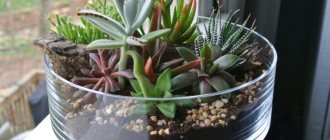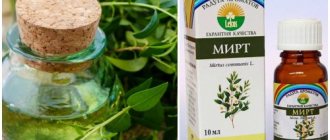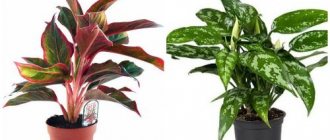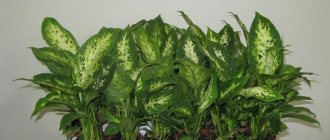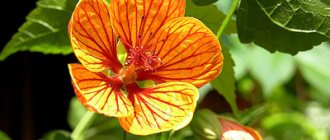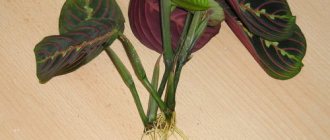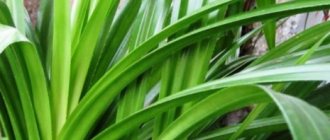The pepper family includes the genus Peperomia. Peperomia bluntifolia is no exception. The tropical regions of Brazil are adorned with these miniature plants. If you translate this name from Greek, it turns out to be similar to pepper, which indicates a direct similarity with this plant.
Each type of peperomia is unique and distinctive. The only difference is the color of the leaves and their structure. They can be collected in a rosette or located on a stem. Peperomia flowers are similar to plantain flowers. Due to the not particularly developed root system, peperomia can be grown in compositions with other indoor flowers.
The main difference between peperomia is that the inflorescences are long, like spikelets, and they look like a mouse’s tail.
Peperomia blunt-leaved is not a tall plant - its maximum height is up to thirty centimeters. Any type of peperomia grows very slowly. Peperomia obtufolia is a wonderful plant for growing at home, which is valued for its good decorative qualities.
You can buy peperomia obtufolia in almost any specialized center and almost all year round.
Peperomia obtufolia - this species has a straight growth form, forming low shoots. If there is not enough lighting, the shoots can bend or reach towards the light. Rotate the pot as needed. Peperomia also lends itself well to pruning; trimmed shoots can be used to propagate this indoor plant.
Appearance and description of the plant
The main difference between all types of peperomia is the shape, color and thickness of the leaves. They are the usual green color, striped, with pronounced veins, white spots, fleshy or flat, curled.
It’s hard to say which ones are more beautiful. You can see small, hairy foliage on the peperomia, as well as the large, spotted, multi-colored variety.
Flowers are divided into three groups according to their shape:
- hanging - with hanging long shoots;
- shrubby – low stocky species, 15–20 cm high ;
- erect - taller varieties, up to 50 cm tall.
Each species has several subspecies and varieties, including hybrid ones. In total there are more than 1,000 names, scattered throughout their natural habitat - subtropics and tropics.
It is generally accepted that this plant is native to South and Central America. In nature, they can grow like epiphytes - on the branches of large trees, which provide them with shade, food and water.
Despite the fact that peperomia is a pepper crop, it is not used as a seasoning in everyday life. This is a full flowering plant that is more suitable for small spaces as it looks compact but luxurious.
The blooms are not as unique as the leaves. The inflorescences are more like plantain blossoms. Some people call them mouse tails.
What does Peperomia obtufolia look like?
Peperomia is a low herbaceous plant from the Pepper family. In nature, this flower lives in Central and South America, as well as in parts of Brazil and Ecuador.
The height of the plant, as a rule, does not exceed 40 cm. The structure of the shoots is thick, the leaves are round, 8 cm in diameter, dense, green, covered with an inconspicuous film. They are attached to the stem using petioles. The peduncles are spike-shaped, similar in shape to the peduncles of plantain.
Pereromia blooms almost imperceptibly, since its flowers are very small and inconspicuous.
The plant is mainly used as a hanging plant and grown on windows or balconies; it also looks good in hanging flowerpots.
There are several varieties of Peperomia obtufolia, their main differences being the color (solid dark green or variegated) and the shape of the leaves (oval, lanceolate).
Did you know? Because of the shape of the inflorescences, peperomia
is popularly called “rat tail”.
Interesting varieties with photos of peperomia
Peperomia obtufolia is best suited for home care, as it does not require special attention, unlike other tropical plants. She does not need a cool winter - the plant rests calmly on the windowsill. The requirements for soil nutrition are the most common, as well as for daylight hours and watering.
To choose a plant for yourself, you need to familiarize yourself with what a peperomia flower is and what types are available in stores. Some you can buy only in seed form and try to grow yourself.
Reproduction
Plant division is quite simple, and several types of propagation are available.
Propagation of peperomia by cuttings
This is the most accessible and popular type of flower division. The cut cuttings are cleared of all leaves except the top ones, left to dry for 1-1.5 hours and planted for rooting in a sand-peat mixture for 1-1.5 months.
The soil temperature should be at least 25C. Many species can be rooted in water. To do this, place the cuttings in warm water and wait for roots to form.
Peperomia propagation by leaf
A leaf separated from the cutting with a petiole of at least 1 cm is treated with root and immersed in a sand-peat mixture.
The container is covered with a bag on top and left at a temperature of 19-21 degrees under diffused lighting. For 1-1.5 months, the soil is moderately moistened, and the pot is turned towards the light so that new rosettes at the base of the leaf form evenly. Then the new root shoots are divided and planted. Their flowering is possible already in the first year.
Some plant varieties, such as silver peperomia, can reproduce from parts of the leaves. The main condition is the presence of a minimum part with which the leaf is attached to the stem.
Shrub species
50 species are cultivated in indoor gardening . Bush-like ones are one of the most beautiful and unusual. They reach 20 cm in height, but attract with their varied foliage - in shape and color.
wrinkled
Peperomia wrinkled received its name for its corrugated leaves, which can be of several colors - green, silver, purple. This is a compact species with short stems, similar to a cap. It blooms in late winter - early spring for two months. Breathable soil rich in organic matter and microelements is required. The plant is thermophilic.
Rosso
Caring for Peperomia Rosso at home comes down to providing it with nutrients - mainly nitrogen and phosphorus. The main interest for gardeners is the leaves. It is necessary to ensure that they are decorative so that the foliage is dark green and glossy.
Lillian
Peperomia caperata blooms beautifully with good care at home. The inflorescences are similar to lilies, which is why the flower was named. The color of the leaves is also of decorative interest - they are green with whitish veins.
Silver
Silver peperomia has an unusual leaf color. The veins seem to be recessed and of a darker color, and the swollen leaf plate is light, silvered. Due to the shortened petioles, large foliage is located very close to each other, which looks very beautiful.
Gray-haired
The “gray” effect is given to the plant by the edge of small hairs on the leaves. This is a fairly large plant that can grow up to 50 cm . Over time, the shoots begin to hang down.
Bambino
Refers to compact terrarium varieties. Peperomia bambino grows up to 15 cm - this is at best. Basically, its bright decorative leaves are used to create compositions in closed terrariums.
Peperomia Obtusifolia
A common type of blunt-leaved peperomia has a yellowish border along the edge. The leaves are shiny due to the waxy coating on their surface. The venation is pronounced and has an arched shape. The flowering is the same as that of all other varieties - inconspicuous, spike-shaped.
Peperomia obtusifolia
The shoots are initially erect, but then bend down under their own weight. The greatest decorative effect is achieved by hanging a flower pot on a wall or in a window opening, allowing the branches to hang down freely. Loves partial shade and daily spraying with warm boiled water.
For a beginner, keeping peperomia is difficult only because it does not tolerate neglect. Every morning it is necessary to check the soil moisture and perform traditional spraying. But bright greenery will be the best reward for daily attention.
Erect species
Many plants of this species have erect stems at a young age, but over time the fleshy leaves begin to outweigh and bend the shoots.
Tupolifolia
The leaves of Peperomia obtufolia have a round or even oval shape, the surface is glossy, without pubescence. There are two varieties:
- with dark green leaves;
- with spotted foliage.
Peperomia obtufolia is the easiest flower to care for; its requirements are similar to those of plants living in the middle zone.
Magnolifolia
Peperomia magnolia foliage resembles a fig tree in its foliage shape. The color is light green, the leaf blades are large, the stems are red. The peduncles are long and directed upward, so their appearance resembles some kind of fantastic plants.
Clusielifolia
Peperomia clusifolia is a multi-colored plant of the pepper family. A distinctive feature is very short petioles and large leaves - up to 15 cm in length and 8 cm in width. The variegated color is complemented by a bright pink edging along the edges of the foliage.
Ferreira
Peperomia ferreira is a succulent that stores moisture in its leaves. In nature it grows in dry places. It is also an epiphyte, so at home you can create entire compositions of tropical palm trees and their cohabitants.
Graveolens
Peperomia graveolens has leaves of unusual shape and color: slightly folded in half, red below, green above. They are fleshy and form a rosette. Flowering in the form of spikelets of a yellowish tint.
Chisel-shaped
Dolabriformis or chisel-shaped peperomia is a succulent. Fleshy, doubled leaves form a star-shaped rosette. Stems with leaves can grow up to 60 cm . This is one of the largest species. It blooms in small inflorescences of a white-green hue.
Variegated
Peperomia variegata is distinguished by its peculiar shade of leaf blades. In appearance it may be similar to clusielifolia, but without edging and a pink tint in color.
Variegated plants cannot be fed with nitrogen fertilizers. In this case, their leaf blades may lose their variegated color and turn green. Such varieties need high-quality lighting to maintain variegation.
Multicarpal
Polybotrya, raindrop or peperomia multitaste is a plant with round leaves. On some, the spouts are elongated and pointed, on others the leaf plates are completely round. The color is dark and glossy.
Peperomia: pruning
Overgrown bushes require formative pruning. This procedure is recommended to be carried out in the spring, but if necessary, you can use the summer or autumn months. Shoots that extend more than 30 cm in length are shortened. A section with 3-4 leaves is left, and the rest is cut off with sharp scissors or pruners.
After a short time, buds will appear at the cut, from which side shoots will grow. If you want to admire a beautiful bush for many years, then you need to take pruning seriously.
Ampelous plants
Hanging varieties can reach a length of 1.5 m . They need to be planted in a pot to avoid damage. Among them there are small-leaved and large-leaved species, which have different shades of stems and leaf blades.
Video: Peperomia - the most frequently asked questions about care
Creeping
Creeping peperomia most prefers soil and air moisture in care, since in nature it grows in wetlands. It is not picky to care for and is very decorative - the leaves can be either a regular green-light green color or variegated.
Golovataya
Peperomia capita glabella in nature is a creeping plant, but at home the stems grow long because they are not damaged. This plant does not have pronounced decorative qualities - the leaves are light green, oval in shape, and medium in size. If you grow a flower under the bright rays of the sun, the less bright the leaf plates become. The stems turn pink when exposed to ultraviolet light.
Round-leaved
This is a miniature compact plant. The size of its leaves is no larger than a penny coin, so it is used in terrarium compositions or in creating bonsai. no more than 15 cm in height .
This is a rather finicky species that can become infected with fungus if you water it carelessly and drops fall on the leaves. It is necessary to use watering through a tray. You should also not keep the bush exposed to direct sunlight.
Whorled
Peperomia whorled differs from similar species in the complete absence of petioles under the leaves, which are collected in whorls of 3 plates. The flower stalks are of interest - they are long and appear in early summer.
Watermelon
A decorative appearance that resembles a watermelon rind in color - a combination of silver and dark green stripes. This is not a hybrid variety, but a completely natural coloring of the plant. The shape of the leaf plate is ovoid, with a sharp nose.
This is more of a ground cover variety; in nature, this species lines the floor of the tropical jungle. Height no more than 12 cm . At home it can become an ampelous plant. It is also used to cover earthen voids under large palm trees.
Reproduction of peperomia at home
Typically, to propagate a plant, you will need to cut off part of it. This is done with a sharp tool (scissors, pliers, pruning shears, a knife - whatever is convenient) so that you can cut off part of the plant in one movement, without the need to saw it off or break it off, since such a “ragged” wound will take longer to heal and is more likely to become infected.
The sections must be sprinkled with crushed activated carbon. This is also done for disinfection, as well as to speed up the healing of the cut.
The cuts are made diagonally, at an angle of 45 degrees, to make it easier for the mother plant to grow a new leaf or cutting to replace the one you took for the new plant.
Leaf
It's very simple: cut off a large, healthy leaf and transplant it into a small pot. The soil can be the same as the mother plant, or you can use seed soil (half leaf soil, half coarse river sand).
It is advisable to place the pot with the leaf in a warmer place than the mother plant - this will speed up growth. It is necessary to water periodically so that the soil does not dry out. Rooting will occur in three to four weeks.
Cuttings
Everything is the same as for rooting with a leaf, but instead of one leaf, a cutting is taken - a part of the stem with a pair of leaves and at least one node. These methods of reproduction are no different.
Growing from seeds
This is a more complex method. As a rule, propagation by seeds is used by professionals, because this method allows you to grow many flowers at once. Here's what you need to do:
Buy seeds or wait for the flower you already have to bloom and collect the berries left after flowering. Planting is carried out immediately after collecting the seeds, since the “fresh” they are, the higher the germination rate.
Plant the seeds in containers. There are many seeds, they are small, so they are planted in furrows at a distance of 8-10 cm from each other.
Composition of soil for seeds: half leaf soil, half coarse sand.
After planting, it is necessary to water the seeds with warm, settled water and cover with polyethylene or glass. Place in a sunny room with an air temperature of at least 25⁰C.
When the seed has hatched, it has two independent leaves - it is planted in a separate small container (an ordinary plastic cup will do) and placed in a sunny place. The composition of the soil is not changed, it is left the same (coarse sand and leaf soil). They are transplanted into mature soil when several pairs of leaves appear and the seedling gets stronger.
Care requirements
Peperomia are not as difficult to care for as they are sometimes described. These are tropical crops, but they have long adapted to the conditions of the middle zone. It is recommended to grow plants taken from friends, as they are more adaptable than those sold in stores.
Depending on the type of flower, care requirements may vary slightly: some need more water, others less. The same goes for lighting and average temperatures.
If the plant was purchased in a store, it is quarantined. This is a general rule for all flowers, according to which the plant is checked for pests and diseases within 2 weeks . Then it can be placed with other crops on the windowsill.
Watering and humidity
In summer the amount of water is more, in winter – less. Glossy and regular species can be bathed in summer when the air temperature exceeds 27 degrees . Spraying and bathing are contraindicated for only two varieties - round-leaved and gray-haired peperomia. After this procedure, they turn black and die.
To protect the roots from excessive watering, it is recommended to fill the pot one third with drainage - stones, broken bricks, river pebbles. This draws liquid away from the roots, creates air pockets, and the root system can breathe without experiencing drought.
The water should be warm, especially in summer. Cold watering in hot weather can cause temperature shock and the roots will begin to rot.
Succulent varieties are rarely watered, as the plants store moisture reserves in case of drought. If you regularly overwater the roots, they will rot.
Lighting
East and west windows are the best option for this plant. It loves a lot of light. South-facing windows let in more light, so it is recommended to darken them with a curtain to avoid burning the leaf plates.
In winter, flowers lack natural light, so everyone who grows tropical crops tries to purchase phytolamps for evening illumination. In total, daylight hours should last at least 10 hours.
Temperature in summer and winter
Peperomia do not tolerate drafts, and all because in their homeland they grow in a humid forest climate where there is no wind. You should try to organize the same conditions at home. It is not recommended to take flowers outside, especially in windy weather - this can cause damage to the leaves.
Optimal temperature for peperomia:
- in summer from 20 to 22 degrees;
- in autumn from 18 to 20 .
The soil temperature must correspond to the air temperature, otherwise problems with the roots may begin. If the plant is on a cold windowsill, then you need to place insulation under the pot - mineral wool, basalt wool or polystyrene foam.
Pruning and shaping the bush
Every spring, peperomia bushes need to be renewed by pruning and cleaning. This procedure is useful in several ways:
- Removing dry leaves from inside the bush allows sunlight and air to penetrate to the young leaves, protecting them from fungus;
- weak and dead shoots are removed so that they do not consume nutrients;
- fallen leaves can become a source of fungal infection, so they must be removed regularly;
- With the help of pruning, a beautiful bush is formed.
Flowering of Peperomia obtufolia is sometimes delayed due to non-compliance with pruning rules.
Beneficial properties and harm
- Peperomia obtufolia is known primarily for its beneficial properties:
- aesthetic - this is a small ornamental plant with bright foliage of unique colors;
- disinfectants - cleans the air in the room from fungi and microorganisms due to the release of phytoncides;
- medicinal - improves the functionality of the stomach and intestines, urinary system and mammary glands.
The flower has no harmful properties and does not pose a danger to humans, since it does not contain any poisons or toxins.
However, Peperomia obtufolia is also accompanied by some superstitions and folk signs. Some of them are probably related to the healing properties of the plant.
- If there is peperomia in the house, love and prosperity will reign in the family.
- By growing this flower, you will protect yourself from quarrels and have enough money.
- It should not be accepted as a gift, as it will bring grief to the family. But if you buy the flower with a coin, misfortune can be avoided.
- If you grow peperomia at home, family members will rarely get sick.
- In the house where this flower grows, loyalty will remain, all family members will be close to each other.
- Being in the same room with a plant, a sick person recovers faster.
- By placing peperomia in the bedroom, you can get a good, healthy sleep.
Reproduction - methods and procedures
Peperomia is usually propagated by cuttings, as this is the most effective method. But there are others:
- seeds;
- sheet method;
- dividing the bush.
The seed method is quite risky, since not all sellers properly store seeds before sale. This reduces germination. The disadvantage of seed propagation is that the hybrid varieties next year will not be as beautiful as the mother plant. Therefore, seeds must either be purchased from the manufacturer, or another method of propagating peperomia must be used.
With the leaf method there is a greater chance of getting a new plant. You must follow the rules and procedures:
- Using a sharp knife, cut off the leaf with the internode or just the leaf.
- Treat it with root to increase strength.
- Place in water or damp soil (it can be done in different ways).
- Cover the container with film to ensure a constant microclimate.
- Wait 2 weeks - during this time roots should form.
- Transplant into a cup with soil.
Important! The soil for peperomia should be light, breathable, but nutritious. A mixture of sand, leaf humus, peat and garden soil is suitable. All components are taken in equal quantities. Plus you need to put drainage at the bottom
During growth, it is necessary to maintain a slightly acidic or neutral environment in the peperomia pot.
Propagating peperomia by dividing the bush is easier than growing from seeds or leaves. To do this, you need to remove the roots from the soil, cut them with a knife so that there is a root for each green part. Next, sprinkle the sections with activated carbon to prevent rotting, dry them a little in the air and plant them in separate containers.
If the bushes are small, they are temporarily covered with a transparent plastic bottle to organize the microclimate and protect the plants from drafts.
How to propagate.
- Reproduction. Indoor Peperomia flowers are propagated by apical cuttings and leaf cuttings. There are two methods of propagation: cuttings and leaves. It is better to propagate Peperomia obtufolia by leaves; to do this, we carefully cut them off and treat them with a growth stimulator, for example, root. We plant the leaves in soil consisting of peat and sand. Watering must be careful, since if the soil is very wet, the leaves begin to rot. The process of propagation by cuttings is simpler; to do this, we cut off the cutting and also plant it in the soil. After a month, the cuttings will give roots and can be transplanted to a permanent location. We carry out rooting in a warm and bright place.
Transfer
It is necessary to replant the bushes as the roots grow. This method allows the root system and top to develop in balance. This means that the size of the roots will correspond to the amount of green matter. If the balance is disturbed, the plant may weaken or even die.
The transplanting rule is that each next pot should be 2 cm larger in diameter than the previous one. This also prevents the soil from becoming too acidic, which will cause bush disease.
How to transplant peperomia:
- A week before transplanting, water the plant with a fertilizer solution to feed it.
- Prepare the soil and a new pot.
- Take out the bush, inspect the roots, remove rotten and dried ones, treat them with activated carbon or a solution of potassium permanganate.
- Make a hole in the soil and place the root there, using your fingers to gently compact the soil around it.
- Pour over warm water.
If the plants are mature and do not grow well, they also need to be transplanted into new nutrient soil, or at least replace the top layer of soil. This is done carefully so as not to damage the root system of the peperomia.
Table: diseases and pests typical for peperomia
| Name | Manifestation | Fighting methods |
| Root and root collar rot | The roots are affected first, followed by the leaves. The bush quickly withers, the root collar becomes watery, and the roots turn black. | At the earliest stage, all damaged parts are cut off, the entire plant with roots is dipped in a solution of the fungicide Switch 62.5 WG and planted in new soil. |
| Viral dwarfism | All parts of the peperomia are smaller than normal size and deformed. | No. |
| Spider mite | Multiple lightened and dried spots on the leaves. | Treatment with acaricides at intervals of two weeks until a positive effect occurs. Nisoran and Apollo are suitable. |
| Thrips | Visible to the naked eye - small (up to 2 mm in length) black insects on the leaves, which become sticky, turn yellow and dry out. | Double treatment with insecticides: actara, fitoverm, mospilan, karate. |
| Mealybug | A white and fluffy, mold-like coating appears on the leaves. | Twice, with an interval of two weeks, treatment with insecticides Fitoverm, Aktara. |
| Nematode | The first to suffer are the roots, which first thicken and then die. They are replaced by thin and sluggish ones. | Treatment with nematophagin and BI-58 helps. |
Important! If the pest is unknown, it is recommended to treat the ground part with afidol. It is sprayed on the shoots and leaves, and washed off after half an hour. After 5 days, the treatment is repeated. In total you will need up to five of them.
Fertilizers
Once a month during the active growing season, the plant must be fed with complex mixtures - liquid or dry.
For peperomia to bloom regularly, it needs potassium. To increase green mass - nitrogen. These two macroelements are introduced at different times: nitrogen in early spring, potassium closer to summer.
In order not to have to worry about calculating the amount of fertilizers yourself, you can buy ready-made mixtures for decorative deciduous plants. For spring fertilizing they will contain more nitrogen, for summer fertilizing - more potassium. The binding element is phosphorus. It is he who stimulates the growth of roots so that they provide nutrition to the above-ground part.
If you make an earthen mixture based on garden soil, it may lack some microelements. To do this, it is recommended to periodically apply fertilizing - a diluted solution containing copper, boron, iron, magnesium and other elements in microscopic dosages.
How to care
- The soil. Peperomia are undemanding to soil. The best option is light and water-permeable. You can also use heavier soil. Small-leaved and low-growing peperomias are best grown in lighter, looser soil. The optimal soil for this is a mixture of equal parts of leaf soil, peat soil and sand (1:1:1). You can also use ready-made universal primer, which can be purchased in shopping centers. It is better to plant the plant in peat soil.
- Landing. Planting is done in prepared soil, which can be prepared by you or purchased ready-made. Select a small pot, since the indoor peperomia flower has a small root system. We select a pot under the root ball. There must be good drainage. Expanded clay can be used for drainage. Add perlite or vermiculite to the soil - this will loosen the soil. We plant it at the same level as the plant was in the planting pot. Gently add soil and tamp it down. Water the plant and add soil if necessary.
- Transfer. It is carried out once every two to three years. Spring time of year is the best for transplantation. Or we replant the plant as needed. This is usually due to the plant having outgrown its pot. With such factors, growth slows down and young leaves become shallow. Another reason for replanting is if the plant’s roots come out through the drainage hole.
